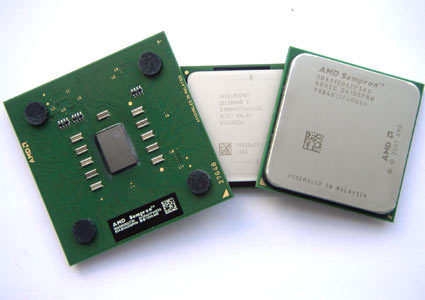Duron Successor: AMD Sempron
AMD's AthlonXP + The Athlon64 = Sempron
Since AMD's Socket 939 launch, AMD has sought to compensate for its Athlon64's large die size to create a high-yield, low-cost processor as a replacement for its Duron line, which represented AMD's value offering for years. Indeed, the Athlon64's yield is not conducive for large-volume production and shipment units. This has thus prevented AMD from introducing slower and more affordable versions for the highly attractive Socket 939.
Meanwhile, AMD's AthlonXP, which the Athlon64 will eventually replace, is out of place in the value segment as the Athlon brand is supposed to represent the best of the best.
AMD solves the dilemma by getting rid of the Athlon nomenclature for its AthlonXP architecture to designate its value segment processors. Hence, the entry of the Sempron brand.
Intel has taken the value processor lead with its recent launch of the Celeron D processor. Based on the Prescott core, using 256 kB L2 cache and running at clock speeds of up to 2.8 GHz (FSB533) the modernized Celeron is a preliminary stage to the LGA 775 version coming with XD bit and Thermal Monitoring 2. Also, the 915G/GV and 910GL chipsets will soon boost the feature level of typical value platforms. Since AMD cannot afford to sit down and wait for the availability of PCI Express enabled chipsets, all existing resources must be squeezed out in order to make Intel's life as hard as possible.
It's weird enough that features like PCI Express, SATA RAID with command queuing or sophisticated audio systems might be interesting in the cost-driven value segment. It will still take many months until the volume of the mainstream component market will start to use PCI Express parts. But as soon as euphonious features are part of the chipset, they can be implemented with only a minimum of additional costs to become strong selling points.
At this conjecture in time, unfortunately, AMD is responsible for our having to write an abridged version of our Sempron review, as AMD pushed forward the launch date from August 17 to today, July 28. We thus did not have time run our usual set of exhaustive processor performance benchmarks.
However, that doesn't mean AMD's Sempron didn't get a reasonably stringent benchmark treatment, either. We put together a decent amount of information and test results in order to compare Sempron 2800+ and the Celeron D 335 at 2.8 GHz. The Sempron 3100+ for Socket 754 based on Athlon64 technology is included, too, but cannot and should not be compared, as it doesn't really belong in the value processor segment due to its speed - and price.
Get Tom's Hardware's best news and in-depth reviews, straight to your inbox.
Current page: AMD's AthlonXP + The Athlon64 = Sempron
Next Page Sempron Is The New Duron
Patrick Schmid was the editor-in-chief for Tom's Hardware from 2005 to 2006. He wrote numerous articles on a wide range of hardware topics, including storage, CPUs, and system builds.
